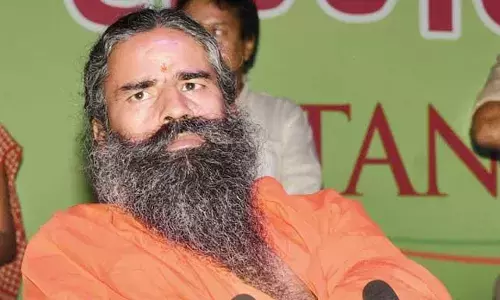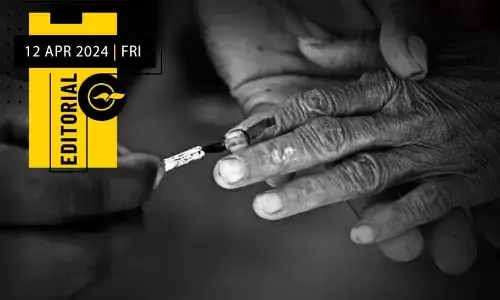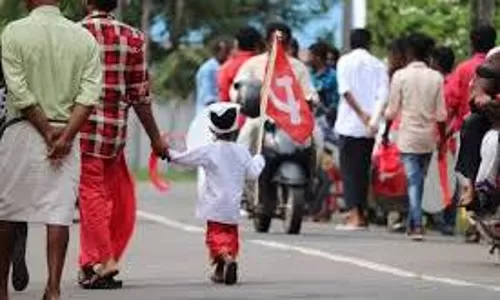
The Bhoomi pujan for Sri Ram Temple
text_fieldsRajya Sabha member of Communist Party of India (CPI) Binoy Vishwam has sent a letter to minister of information and broadcasting, Prakash Javadekar pointing out that the decision of state-owned medium Doordarshan to telecast live the bhoomi pujan of Sri Ram Temple scheduled for 5 August, is against the Prasar Bharati Act which governs the functioning of the channel. The MP's letter contains as much substance as some room for mirth – the latter not because its content is wrong or baseless. It is also true that the conduct of the national medium Doordarshan is bound to uphold the values of unity and integrity of the country enjoined by the Constitution, as laid down in Clause 12.2A of the Prasar Bharati Act.
Binoy Vishwam's letter also makes a key point that in a country constitutionally committed to secular democracy, the religious sentiments of all sections ought to be given equal treatment. But the letter turns amusing only, and mainly, given that it is amply clear who is ruling the country and with what end, and for what they use the entire resources of the country, including media – all factors that would make the letter infructuous. An examination of the Ram temple movement hitherto alone would tell the secret why the run-up to and celebration of, the bhoomi pujan of 5 August is being made so colourful.
It was when the country had a secular democratic rule in 1987 that the visual media of Doordarshan telecast the Ramayana serial. The emotional thrust given by Ramananda Sagar's television version of Ramayana, and the viewership interest it attracted, had given a no small fillip to the sangh parivar. Even earlier, when the case about the Babri masjid in Faisabad, where Muslims had offered prayers for four centuries, was pending in the court the Uttar Pradesh government had unilaterally opened the premises for puja by Ram devotees. The long-pending case had been before the court ever since the pro-Hindutva district collector KK Nayar in 1949 blocked entry of Muslims in support of Hindutva claim on its ownership. And it is too early to forget the UP government's act of laying a foundation stone for a temple at the same spot and the prolonged atmosphere of communal tension deliberately created through rabble-rousing campaigns.
The very identity of Ram Chandra, the place and time of his birth, and whether he was a legendary character or a real person are all matters on which historians have till now been unable to reach unanimity. A few days ago, the Nepalese prime minister too did come out with a claim that the birth place of Sri Ram is in Nepal. But none of this seems to matter to the present-day exponents and warriors of Arsh Bharat culture, bent on pursuing the pre-historic roots of Hindutva racism. For them, proof of the age and greatness of Bharatiya nationalism lies more in myths than in historical truth. It was as a successful culmination of the nearly century-long endeavour to win over the majority community of India to this stream of thought that a government committed to Hindutva philosophy came into being under the leadership of Narendra Modi in the second decade of the 21st century. The one factor that aided them for the build-up to this, is undoubtedly the agitation and campaign to regain ownership of the 'Sri Rama janmasthal' and to build a Ram temple there.
Last year, in settling the long-pending dispute, the highest court of the country stated unambiguously that there is no evidence to prove that the Babri masjid was built in 1528 on a land where there was a temple or that Muslims had not offered prayers there. And it is not to be forgotten that the court also judged that it had to take into account the Hindu community's sentiments and belief about Ayodhya as Ram's birthplace and therefore was granting permission to the government for construction of a temple at the location. As a result, the campaigners are in an elated mood with the Sri Ram Janmabhumi Temple trust going to build a temple at a cost of Rs 2500 Cr whose Bhoomi pujan is going to be held with the presence of prime minister Narendra Modi and also of LK Advani, Murli Manohar Joshi, former UP chief minister Kalyan singh – the three accused in the Babri masjid demolition case - RSS Sarsanghchalak Mohan Bhagwat and yoga guru Baba Ramdev.
When India is reeling under the Covid-19 pandemic with a daily caseload of 50,000 across the country and stands third in mortality, even this alarming situation takes only second place in the priorities of prime minister Modi. If Modi comes up with a pet recipe of rhetoric of stiff warnings against arch-enemy Pakistan and jubilation over realisation of the temple dream, that will clear the path for BJP to win big in the assembly elections to be held towards the end of the year in Bihar. What more should one ask for in the name of democracy, secularism and integrity? As for Covid protocol and Prasar Bharat law, better not talk about them.























